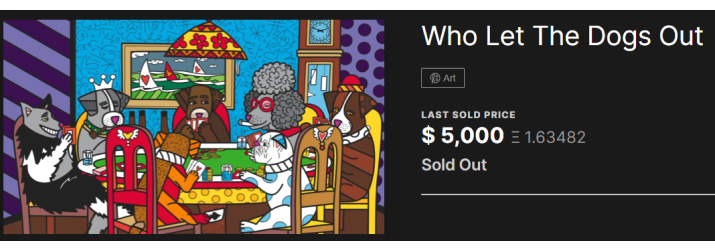NFTs have been around for years — the first was created in 2014 — but their popularity has exploded more recently, with sales surpassing $40 billion in 2021. NFTs aren’t just one thing, rather they can take the form of multiple digital file types that include JPGs, WAVs, MP3s and GIFs.
And along with other artists, musicians are jumping on the NFT hype train as a way to compensate for shortcomings in more traditional markets, including low payouts from music streaming services.
What are music NFTs?
A music NFT is typically tokenized album art or music files that exist on a blockchain — a public ledger on which transactions are recorded. Short for “non-fungible token,” an NFT is a unique asset that identifies ownership of a digital asset, the “non-fungible” part referring to its inability to be changed or replaced.
Collectors purchase music NFTs to display in their personal gallery or sell on the secondary market with hopes of earning a profit. It’s not only the NFT that’s recorded on a blockchain: Each transaction involving that NFT is recorded as well, allowing for the musician who minted the music NFT to earn royalties on each subsequent sale.
The band Kings of Leon was the first to release an NFT album in 2021 as part of an “NFT Yourself” series that included an NFT special album package, an NFT with a chance for front-row seats for life and NFTs with exclusive audiovisual art.
Since then, we’ve seen other big-name musicians and artists like Portugal. The Man, Emery Kelly, Grimes, Steve Aoki and Eminem enter the music NFT game — but why?
Like most things, it often comes down to money. Modern streaming services like Pandora and Spotify pay very low profits per stream, with streaming payouts between $0.00133 and $0.00437, depending on the service.
By releasing a physical album alongside NFT-linked vinyl records, musicians can earn royalties through resales. And they can use NFTs to engage with their fans by attaching exclusive IRL perks to their tokens.
What does a music NFT look like?
Most music NFTs are accompanied by an animated or static image and “play” button that allows you to listen to and pause the music within it. Some music NFTs are entire albums, with others as short sound bites.

Image source: YellowHeart
As music NFTs evolve, you’ll see a combination of animated images and audio files, often inspired by an album’s artwork. For example, Maroon 5’s 2021 Maroon 5 NFT Collection features animated album artwork and portrait bundles of the band. The collection was released on the NFT marketplace YellowHeart, a popular music and art NFT marketplace.

Image source: YellowHeart
NFT marketplaces
NFT marketplaces are online platforms where users can mint, sell and buy NFTs. You’re typically required to connect a digital wallet and purchase an NFT with cryptocurrency, though some marketplaces allow for debit and credit card transactions. Many marketplaces run on the Ethereum blockchain and require Ether (ETH) for trading.
Some marketplaces include auctions that require bidding on an NFT, the bidder paying for each bid transaction.
Some marketplaces specialize in NFT genres — such as the art marketplace Foundation that focuses on spotlighting small digital art creators. Other marketplaces focus solely on sports, like NBA Top Shot. Music NFTs are a popular genre that you’re likely to find on multiple mixed platforms, such as OpenSea, Nifty Gateway and NFT Magicbox.
The key to finding the right marketplace for you lies in what NFTs you want to collect. If you aren’t focused on a genre, mixed marketplaces are a good starting point.
Compare music NFT marketplaces
How to make money with music NFTs
Creators can make money with music NFTs through royalties on minted NFTs or by buying and selling music NFTs.
Become a creator
Creators start by opening an account with a marketplace and creating the digital file to be tokenized. Creators that mint their NFTs earn royalties through smart contracts. These contracts rely on code to determine ownership, allow for transferability when the NFT is sold and ensure the NFT can’t be replicated, so that its original creator can continue earning on subsequent sales.
Each time the NFT is sold, the creator collects a percentage of the original sale price — typically between 1% to 10%. You’re charged a transaction fee to mint the NFT — called a gas fee — that’s similar to a processing fee on your credit card.
There’s no guarantee that someone will buy your NFTs. An NFT’s value can be determined by the ethos of the creator, its use and even its rarity.
Buy and sell
The trick to buying and selling nfts for a profit follows the golden rule of investing: buy low and sell high. Like many investments, there’s no guarantee that the NFT you buy is going to make you money — and you could end up losing it.
Celebrities have joined in on the action. Snoop Dogg is one who’s wallet holds around $17 million in NFTs, according to Decrypt. Owning a notable collection can get expensive quickly unless you manage to purchase highly valuable NFTs for cheap.
How to buy music NFTs
Buying an NFT follows a general set of steps that vary by marketplace:
- Set up a digital wallet. Marketplaces require you to either use a proprietary digital wallet or connect your own to the platform. Many top cryptocurrency wallets like MetaMask or ZenGo are widely accepted and allow you to store digital assets like crypto and NFTs in the same place.
- Add crypto to your wallet. Most marketplaces require you to purchase an NFT with cryptocurrency. Add or transfer the amount you need to buy the NFT you want. Marketplaces require different currencies, but ETH is most widely accepted.
- Choose your marketplace. For music NFTs, we recommend larger mixed marketplaces such as OpenSea and Gate.io’s MagicBox. Compare marketplaces to find the one that suits your interests.
- Choose and buy the NFT. After your wallet is funded, buy or bid on the NFT you want. Once the transaction is complete, the NFT is sent to your wallet and the cost deducted from your balance.
Wallets like those through Coinbase and Gate.io allow you to display your NFTs from your device of choice.
How to store and protect your NFTs
NFTs are sent to the wallet you used to purchase them after successful purchases. When you set up your wallet, you’re given a seed phrase or key – a master password – to minimize the chance of hackers breaking into your wallet and stealing your digital assets.
You will find two general types of wallets:
- A custodial wallet is one where a third party controls the keys to your wallet for you.
- A noncustodial wallet gives you full control over the keys, and it’s your responsibility to remember the key phrases given to you at set up.
When choosing between a custodial or noncustodial wallet, consider how involved you’d like to be in protecting your seed phrase or key. If you lose or forget these passwords, they typically can’t be recovered – and a hacker could steal the assets from the wallet if they gain access. Decentralized finance offers little to no recourse for NFT or cryptocurrency theft.
How to create and sell music NFTs
Creating or selling an NFT starts with minting one. Minting is the process mapping of a digital file on a blockchain, where it lives forever without changes.
The platform you use to mint the music file or album art handles the technical aspect of creating the music NFT, as long as you supply the correct file type and pay the transaction fee required to mint the file.
Follow these general steps to create and sell your own music NFTs:
- Select the music file or album art to mint. Most music NFTs are album art, a sound clip or a combination of the two — like an audiovisual NFT. Most marketplaces accept file formats MP3, MP4 and WAV, if you’re doing audio. You may need to compress files larger than 100MB.
- Submit your NFT’s details. Most marketplaces display obvious buttons and guidance to mint an NFT, including fields for a title, description, tags and genre. Most marketplaces also allow for creators to link to social media.
- Complete the minting. You’ll pay a gas fee to digitize your NFT. These varying fees cover the energy required to validate the transaction.
- Choose a sale method. List your newly minted NFT for sale on the marketplace. You often have the option of listing it for a fixed price or setting it up for auction. A few marketplaces, like OpenSea, allow for private sales.
Your biggest decision may be selecting the marketplace you want to mint and sell on. Marketplaces determine your royalty percentage that extends across all future sales.
NFT music fees
Tokenizing an NFT requires a gas fee — a transaction fee that covers the costs of minting your NFT on the blockchain.
How much you pay when tokenizing a digital file depends on the time of day, how fast or slow the blockchain is moving and consumer demand for the currency and blockchain your marketplace uses.
Why buy music NFTs?
As music NFTs evolve, reasons you might want to buy one will grow too:
- Invest in your favorite musician. With big names releasing NFTs tied to physical albums, fans can directly invest in their favorite musicians and bands.
- IRL perks. Musicians often attach tangible perks to their NFTs. In the case of Kings of Leon, a perk of buying its NFT was the chance to win front-row tickets for life.
- Buy and sell valuable NFTs. Consumer interest largely drives the value of an NFT. If a famous musician mints an NFT, it could hold value over time.
- NFTs are collectible. NFTs are an extension of the albums, vinyl records, instruments, posters and T-shirts fans collect to support their favorite musicians
- Proven authenticity. NFTs you own can’t be altered in any way, with a transaction history that’s public. If you purchase a musician’s NFT, proving they minted it can be as easy as going into the smart contract of the NFT.
What makes music NFTs valuable?
As you may expect, NFTs minted by well-known musicians are likely to be valued higher — just like your uncle’s guitar probably isn’t worth as much as Jimi Hendrix’s. With music NFTs, a big contributor to value is the musician or creator that minted the NFT and its historical significance.
An NFT’s value is largely determined by:
- Ownership history — Who owned and minted the NFT.
- Historical significance — Kings of Leon was the first band to mint an entire album, generating around $2 million in 2021 from the NFT collection sales and resales.
- Specific use — For a music NFT, free concert tickets and other IRL owner perks can increase its value.
- Famous provenance — CryptoPunks is a famous NFT pixel art collection, credited for jump-starting the art NFT movement. Many of these NFTs go for hundreds of thousands of dollars. Snoop Dogg owns a few as well.
NFT music collections
Here are few of the highest-valued NFT music collections to date:
- Dream Catcher, $4.25M — Created by American producer and DJ Steve Aoki, minted on Nifty Gateway.
- Shady Con, $1.78M — Created by American rapper Eminem, minted on Nifty Gateway.
- When You See Yourself, $2M — Created by the American band Kings of Leon, minted on YellowHeart.
What to watch out for
With DeFi scams, there’s likely no recourse if you’re scammed or your assets are stolen. NFT marketplaces act as a third-party entity — merely a platform for creators and collectors to list and sell NFTs — and are generally not liable if something goes wrong with a transaction.
Keep your digital wallet passwords safe, and consider placing it in a safe deposit box for safekeeping.
NFTs can be risky, so do your research before dropping big bucks on an NFT. Research its ownership history, and only spend what you can afford to lose.
More guides on Finder
-
Best private business loans in Canada
Check out some of the best private business loans in Canada to help you through seasonal shifts.
-
Apps like Wagepay for quick funding
Compare payday lenders and cash advance providers that offer loans like Wagepay.
-
Loans Like CreditNinja
Check out fees and features of these personal loan alternatives to CreditNinja in Canada.
-
Finder’s Editorial Review Board and expert contributors
Our expert contributors are a key part of Finder’s content. Learn more about the opportunities for experts who work with us.
-
Loans like Eastern Loans
Compare nine Eastern Loans alternatives to find funding that suits your needs.
-
Compare short-term loans in BC
Find out where to get a short-term loan in BC and how to get funded fast.
-
Same-day loans in Canada to help pay for emergencies
In a tight spot? These same-day loans can help, but they’re not all the same.
-
Best loan apps in Canada
Use our list to compare the best loan apps in Canada.
-
RBC Flex Choice Business Account Package review
Learn about the supported transactions, features and fees of the RBC Flex Choice Business Account Package.
-
How to Open a Chequing Account Online
With most banks, opening a chequing account online is a straightforward process

